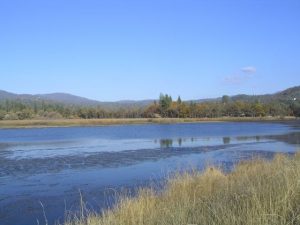Have you ever looked at a drop of water under a microscope? From a seemingly clear little orb of liquid emerges a whole world teeming with life: cells of plant matter, protozoa, insect larvae and other life forms vie for existence. In this one drop is reflected the whole pond, with its fish and plants; and in this pond is reflected the entire garden which, in turn, is a microcosm of Nature as a whole. The pond has an impact on your garden just as your garden has an impact on the environment. Keeping your pond healthy, clean and weed free ensures that your garden and the environment around you are benefitting from its existence.
The most important decision about a pond is what to put in it. But before you put anything in the water, think about its effect on the environment. If you plant invasive plants, even though you won’t necessarily be able to see it for yourself, you will be threatening the hills and streams in Tuolumne County, and California waterways, as well.
A major misconception about pond plants is that, since they are contained within the pond, they can’t escape to propagate anywhere outside. But remember that these plants flower and have pollen; seeds can be carried by the wind, visiting insects, and birds out into the streams and hills of the Sierra Nevada. Unfortunately, some of the invasive plants like parrots feather (Myriophyllum spicatum), water hyacinth (Eichornia crassipes), watercress (Rorippa nasturtium) and yellow iris (Iris pseudoacorus) to name a few, are readily sold in local nurseries and water garden stores because they are pretty.
Water hyacinth, especially, is deadly to lakes and streams because it proliferates and clogs the surface, cutting off sunlight and oxygen and killing the life beneath. It is illegal to bring this plant across state lines and it is illegal altogether in Texas and Florida. There are numerous native and non-invasive plants to put into the pond that are just as pretty and will make a safe, lovely environment for birds, fish, and the myriad critters who visit your garden.
Choose blue flag iris (Iris missouriensis) for example. The flowers range from white to blue to lavender. For a list of native aquatic plants, try the Internet. The California Invasive Plant Council http://cal-ipc.org/ (search aquatic plants) is an excellent resource for picking out what to plant in your pond.
When stocking a pond with fish, many new pond keepers tend to overstock. This results in a nitrogen cycle mismanagement that can kill off part of the fish population. It is best to introduce the fish a few at a time, a few days apart so they can acclimate. Since goldfish and koi (nishiki-goi) reproduce readily, it is better to have fewer fish. A good rule of thumb is an inch of fish to seven gallons of pond water. A pH level of 6.6 to 8.4 is safe. If it becomes necessary to adjust the pH it should be done gradually as a sudden pH change can kill fish.
Although fish cannot be spread on the wind, they are also invasive if dumped into lakes or waterways. If you want to get rid of a fish, give it to another pond owner or to someone with an aquarium. The common goldfish is invasive if let out into streams or lakes. They are copious eaters and prolific breeders and can take over a lake in very little time.
There is nothing more restful in the garden than the sound of water rippling merrily over beautiful fish and flowers. There is nothing more beautiful than the garden reflected in the water. And there is nothing more satisfying than knowing your impact on the environment is a positive one.
Francie McGowan is a Tuolumne County Master Gardener who thoroughly enjoys her high elevation garden and pond.


